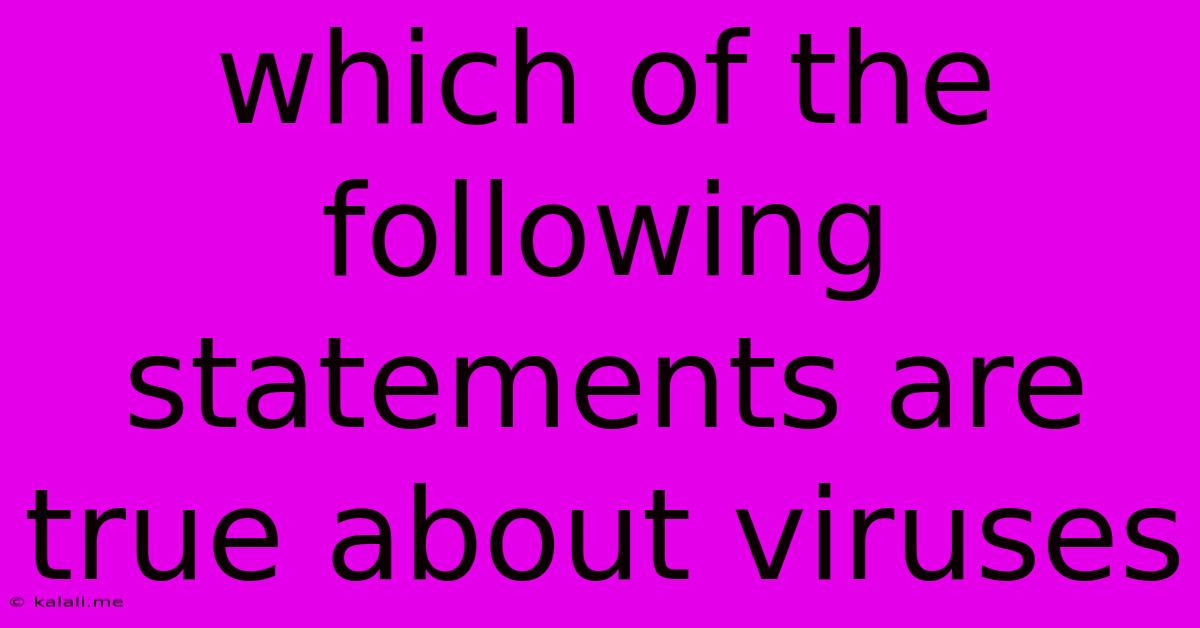Which Of The Following Statements Are True About Viruses
Kalali
Jun 15, 2025 · 3 min read

Table of Contents
Which of the Following Statements Are True About Viruses? A Comprehensive Guide
Viruses. These microscopic entities are ubiquitous, impacting everything from our health to global economies. Understanding their nature is crucial, and often riddled with misconceptions. This article will dissect common statements about viruses, separating fact from fiction. We'll explore their structure, reproduction, evolution, and impact, providing a comprehensive understanding of this fascinating and often-feared biological entity.
What are Viruses? Before we delve into the true and false statements, let's establish a basic understanding. Viruses are submicroscopic infectious agents that replicate only inside the living cells of an organism. They're not considered truly "alive" in the same way as bacteria or other cellular organisms because they lack the cellular machinery for independent metabolism and reproduction. They're essentially genetic material (DNA or RNA) encased in a protein coat, sometimes with an additional lipid envelope.
Now, let's tackle some common statements about viruses and determine their validity:
Statement 1: Viruses are living organisms.
FALSE. While viruses exhibit some characteristics of living things, such as evolution and reproduction (though reliant on a host cell), they lack key features. They don't independently metabolize, meaning they can't generate energy or synthesize proteins on their own. This dependence on a host cell for replication is a defining characteristic that differentiates them from living organisms.
Statement 2: Viruses can be killed by antibiotics.
FALSE. Antibiotics target bacterial cells, interfering with their metabolic processes. Because viruses lack their own metabolic processes and rely on the host cell's machinery, antibiotics are ineffective against them. Antiviral medications work differently, targeting specific stages of the viral life cycle within the host cell.
Statement 3: Viruses evolve and mutate.
TRUE. Viruses have high mutation rates due to their simple structure and often error-prone replication mechanisms. These mutations can lead to variations in their virulence (disease severity), transmissibility, and ability to evade the immune system. This is why new viral strains and outbreaks regularly emerge. Influenza virus is a prime example of a virus with significant annual mutations, requiring updated vaccines.
Statement 4: All viruses cause disease.
FALSE. While many viruses are pathogenic, causing diseases ranging from the common cold to AIDS, not all viruses are harmful. Some viruses exist in a symbiotic or commensal relationship with their host, meaning they don't cause disease. Bacteriophages, for example, are viruses that infect bacteria, and are sometimes used in research and potential therapies.
Statement 5: Viruses can be prevented through vaccination.
TRUE. Vaccines stimulate the immune system to produce antibodies and memory cells against specific viruses. This provides immunity or reduces the severity of infection if exposure occurs. Vaccination is one of the most effective public health interventions for preventing viral diseases.
Statement 6: Viruses only infect animals.
FALSE. Viruses infect a wide range of organisms, including animals, plants, fungi, and even bacteria. Each type of virus has evolved to infect specific host cells, possessing mechanisms to attach to and enter those cells.
Statement 7: Viruses can be easily destroyed with soap and water.
TRUE. While not all viruses are equally susceptible, many enveloped viruses (viruses with a lipid membrane surrounding their protein coat) can be effectively inactivated by soap and water. Soap disrupts the lipid envelope, rendering the virus inactive and unable to infect cells. This is a crucial aspect of hand hygiene in preventing the spread of viral infections.
Understanding the true nature of viruses is essential for developing effective preventative measures and treatments. By dispelling common misconceptions and understanding the scientific facts, we can better protect ourselves and communities from the impact of viral diseases.
Latest Posts
Latest Posts
-
Maximum Deflection In A Cantilever Beam
Jun 16, 2025
-
Which Of The Following Is True About An Ssd
Jun 16, 2025
-
What Happens To Acceleration When Mass Is Doubled
Jun 16, 2025
-
Which Type Of Coal Has The Highest Heating Capacity
Jun 16, 2025
-
Change Fraction To Improper Fraction Calculator
Jun 16, 2025
Related Post
Thank you for visiting our website which covers about Which Of The Following Statements Are True About Viruses . We hope the information provided has been useful to you. Feel free to contact us if you have any questions or need further assistance. See you next time and don't miss to bookmark.